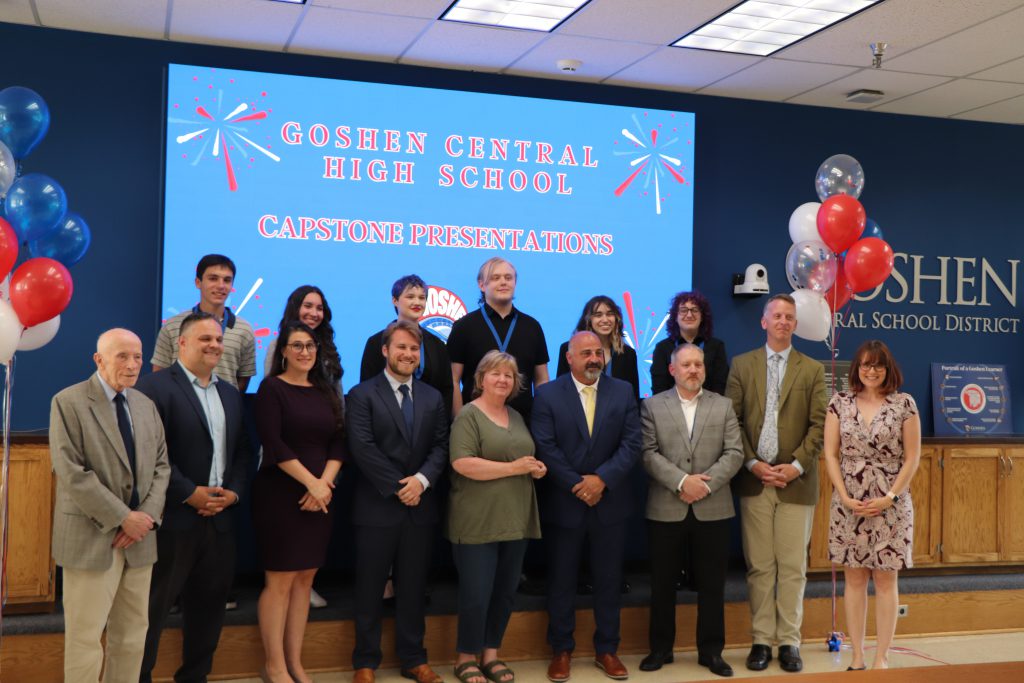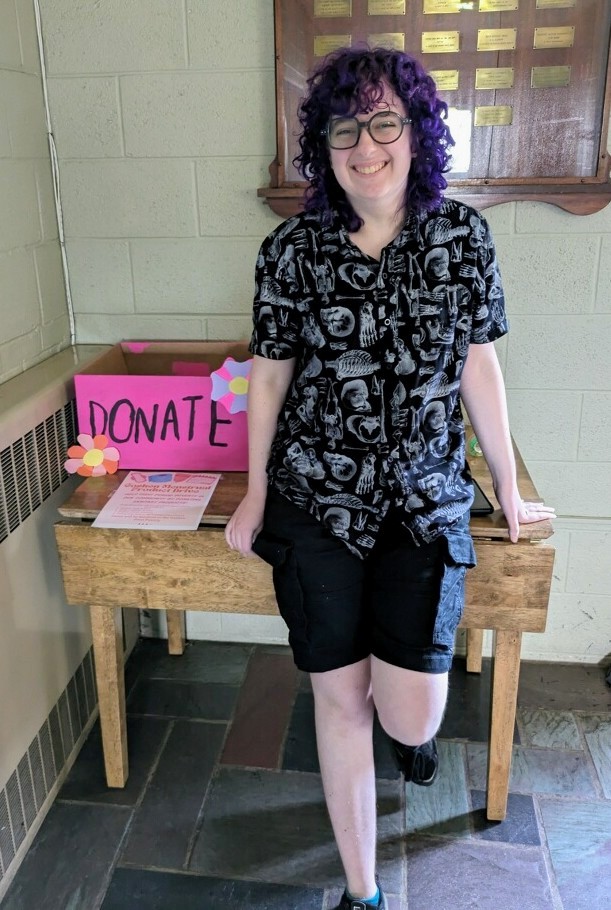
Six Goshen High School students with a penchant for community service completed capstone projects this semester in hopes to make a final mark on their town before graduation and prepare for a future of civic engagement.
These projects, part of the Civic Action and Leadership course, led by GHS Social Studies Teacher Hunter Mullane, also count toward the New York State Seal of Civic Readiness. The seal is a formal recognition for seniors who have attained a high level of proficiency in civic knowledge, skills, mindset and experiences, and is being offered for the first time this year.
The high school curriculum incorporates the requirements needed for most students to earn the seal by graduation, and an early estimate shows almost 90 percent of seniors will qualify in the first year of the program, according to GHS Social Studies Teacher Marie Panzer. In addition to the seal, students completing the capstone project were also honored with a medal after presenting to a group of panelists on May 29.
A spark
Between personal experiences and research, participants in the course determined the focus of their civic leadership projects to solve problems or enhance offerings in the community.
Some projects, like Aiden Thornell’s, were inspired by the desire to solve a problem.
“On my bus, I will sit for over 10 minutes waiting at the intersection to get into school,” the junior said. “Sometimes this makes me late due to something out of my control. I’ve always wanted to try and help my community in some way and this class was a great way to try to enact change in my town.”
Aiden designed his project to mitigate traffic at the high school during morning drop offs.
Other projects, like Amanda Fernandez’s Buddy Brigade, a GHS and Scotchtown Avenue Elementary School student peer mentorship program, and Morgan Taylor’s academic peer mentorship program at the high school, were designed to build off of positive experiences the students have already had in the district.
Amanda was inspired after reading to second graders for the Bilingual Read-Aloud during Hispanic Heritage Month last October.
“I saw how excited the younger kids were to see older kids in their class,” said Amanda. “The program will help younger students grow a love for learning and advance socially, academically and emotionally.”
When Morgan struggled in school with anemia and a Vitamin D deficiency during her freshman year, her math teacher took extra time after school to help her in ways she learned best. It was this kindness that sparked her idea to create a high school peer mentorship program.
“Asking for academic help can make you feel very vulnerable,” she said. “I wanted to make a place for students to feel comfortable.”
Overcoming obstacles and adjusting plans

However, identifying problems and conducting research was just the tip of the iceberg for students, who were tasked with organizing plans they could follow throughout the semester.
Rox Aclin, organizer of the menstrual product drive, said taking notes and making shifts was important to create a successful project.
“I go to the Goshen Food Pantry when it distributes the products every two weeks to see what is the most popular, and see what runs out the quickest,” the senior said. “Then I can adjust the donation requests based on demand.”
Senior Michael Lombardi’s joint civic engagement and Eagle Scout project involved building an information kiosk to spread awareness about the Otter Kill and Black Meadow Creek tributaries– deemed “threatened streams” by the state Department of Environmental Conservation. He said he also needed to make adjustments to his plan to comply with town and safety regulations.
Students also took risks outside of their comfort zone, said junior Karley Davila who organized a town clean-up to beautify the Town of Goshen and reduce ground pollution.
“It takes work and dedication outside of the classroom,” she said. “But, it’s a great experience. Now, I enjoy discussing my project with officials from the town.”
Jumping hurdles wasn’t always a guarantee their resolutions could be put into action, however.
Aiden came up with three solutions to mitigate the standstill at the GHS intersection, but there are some problems that require more than one semester to solve.
“Unfortunately, all three ideas were politely declined due to the cost and amount of construction required,” he said.
Assessing results
Panelists commended Aiden after his presentation for his persistence and willingness to go back to the drawing board, noting that even if change isn’t possible right away, there is much to be learned from every setback.
Those students who could get their projects off the ground may see their efforts sustained even after the school year or their time at the high school comes to an end.
In seven weeks of peer mentorship sessions, Morgan was able to coordinate 77 hours for students to receive help after school by 32 peer volunteers.
“It’s amazing to see the students and mentees, the demand for it, kids helping kids,” said GHS Principal Nick Pantaleone. “You created not only a model for Goshen, but other schools to follow as well.”
Amanda’s Buddy Brigade is set to begin in the fall of 2024 with five high school student volunteers already selected, despite the fact that she is graduating this summer, and Karley is planning a regular town clean-up scheduled for every third Saturday of the month.
Rox’s project sparked a conversation with Susan Armistead of the Goshen Food Pantry regarding menstrual product donations for nurse’s offices in Goshen schools as a way to extend the drive and keep working toward open access for those in need.
“We take for granted that our girls can just reach into the cabinet and get what they need,” she said.
Whether their hard work was met with enthusiastic steps toward change, or walls built by budgetary limitations and red tape, the dedicated Goshen students have taken critical steps toward their futures as engaged citizens and can now bring these experiences with them wherever they go.
“Your project doesn’t need to be on a grand scale or even hard,” Aiden said. “Even little changes in your community can cause ripples and lead to great things.”
